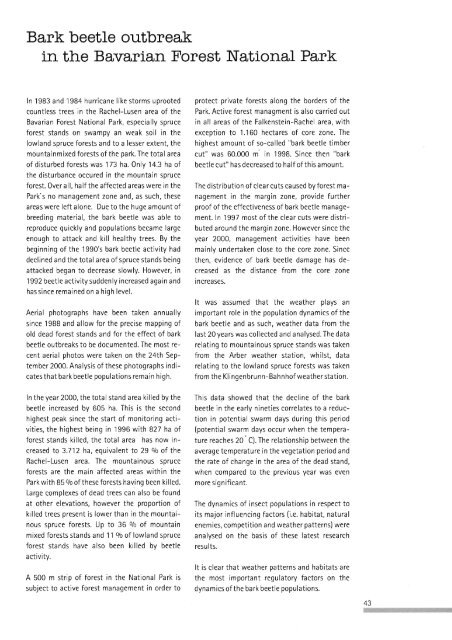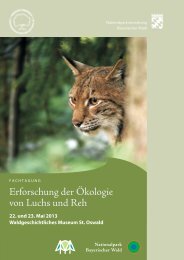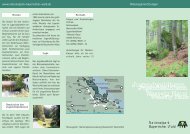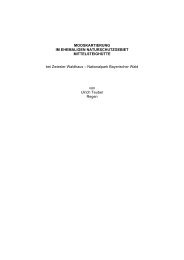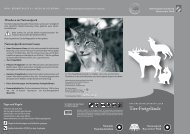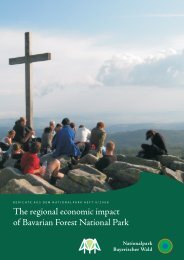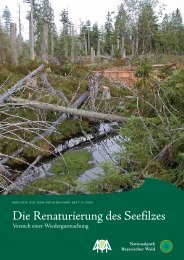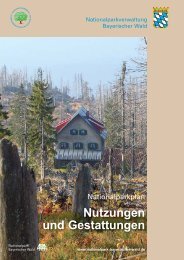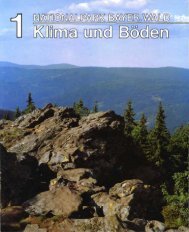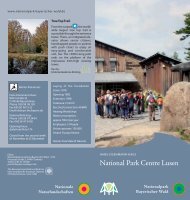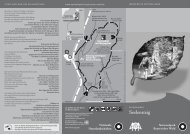Heft 14 - Nationalpark Bayerischer Wald
Heft 14 - Nationalpark Bayerischer Wald
Heft 14 - Nationalpark Bayerischer Wald
Sie wollen auch ein ePaper? Erhöhen Sie die Reichweite Ihrer Titel.
YUMPU macht aus Druck-PDFs automatisch weboptimierte ePaper, die Google liebt.
Bark beetle outbreak<br />
in the Bavarian Forest National Park<br />
In 1983 and 1984 hurricane like storms uprooted<br />
countless trees in the Rachel-Lusen area of the<br />
Bavarian Forest National Park, especially spruce<br />
forest stands on swampy an weak soil in the<br />
lowland spruce forests and to a lesser extent, the<br />
mountainmixed forests of the park. The total area<br />
of disturbed forests was 173 ha. Only <strong>14</strong>.3 ha of<br />
the disturbance occured in the mountain spruce<br />
forest. Over all, halfthe affected areas were in the<br />
Park's no management zone and, as such, these<br />
areas were left alone. Due to the huge amount of<br />
breeding material, the bark beetle was able to<br />
reproduce quickly and populations became large<br />
enough to attack and kill healthy trees. By the<br />
beginning of the 1990's bark beetle activity had<br />
declined and the total area of spruce stands being<br />
attacked began to decrease slowly. However, in<br />
1992 beetle activity sudden Iy i ncreased aga i n a nd<br />
has since remained on a high level.<br />
Aerial photographs have been taken annually<br />
since 1988 and allow for the precise mapping of<br />
old dead forest stands and for the effect of bark<br />
beetle outbreaks to be documented. The most re<br />
cent aerial photos were taken on the 24th September<br />
2000. Analysis of these photographs indi<br />
cates that bark beetle populations remain high.<br />
In the year 2000, the total stand area killed by the<br />
beetle increased by 605 ha. This is the second<br />
highest peak since the start of monitoring activities,<br />
the highest being in 1996 with 827 ha of<br />
forest stands killed, the total area has now increased<br />
to 3.712 ha, equivalent to 29 % of the<br />
Rachel-Lusen area. The mountainous spruce<br />
forests are the main affected areas within the<br />
Park with 85 % ofthese forests hav,ing been killed.<br />
Large complexes of dead trees can also be found<br />
at other elevations, however the proportion of<br />
killed trees present is lower than in the mountainous<br />
spruce forests. Up to 36 % of mountain<br />
mixed forests stands and 11 % of lowland spruce<br />
forest stands have also been killed by beetle<br />
activity.<br />
A 500 m strip of forest in the National Park is<br />
subject to active forest management in order to<br />
protect private forests along the borders of the<br />
Park. Active forest managment is also carried out<br />
in all areas of the Falkenstein-Rachel area, with<br />
exception to 1.160 hectares of core zone. The<br />
highest amount of so-called "bark beetle timber<br />
cut" was 60.000 m' in 1998. Since then "bark<br />
beetle cut" has decreased to ha If of th is a mou nt.<br />
The distribution of clear cuts caused by forest ma<br />
nagement in the margin zone, provide further<br />
proof of the effectiveness of bark beetle management.<br />
In 1997 most of the clear cuts were distri<br />
buted around the margin zone. However since the<br />
year 2000, management activities have been<br />
mainly undertaken close to the core zone. Since<br />
then, evidence of bark beetle damage has de<br />
creased as the distance from the core zone<br />
increases.<br />
It was assumed that the weather plays an<br />
important role in the population dynamics of the<br />
bark beetle and as such, weather data from the<br />
last 20 years was collected and analysed. The data<br />
relating to mountainous spruce stands was taken<br />
from the Arber weather station, whilst, data<br />
relating to the lowland spruce forests was taken<br />
from the Klingenbrunn-Bahnhof weather station.<br />
This data showed that the decline of the bark<br />
beetle in the early nineties correlates to a reduction<br />
in potential swarm days during this period<br />
(potential swarm days occur when the tempera<br />
ture reaches 20 ' Cl. The relationship between the<br />
average temperature in the vegetation period and<br />
the rate of change in the area of the dead stand,<br />
when compared to the previous year was even<br />
more significant.<br />
The dynamics of insect populations in respect to<br />
its major influencing factors (i.e. habitat, natural<br />
enemies, competition and weather patterns) were<br />
analysed on the basis of these latest research<br />
resu Its.<br />
It is clear that weather patterns and habitats "are<br />
the most important regulatory factors on the<br />
dynamics ofthe bark beetle populations.<br />
43


